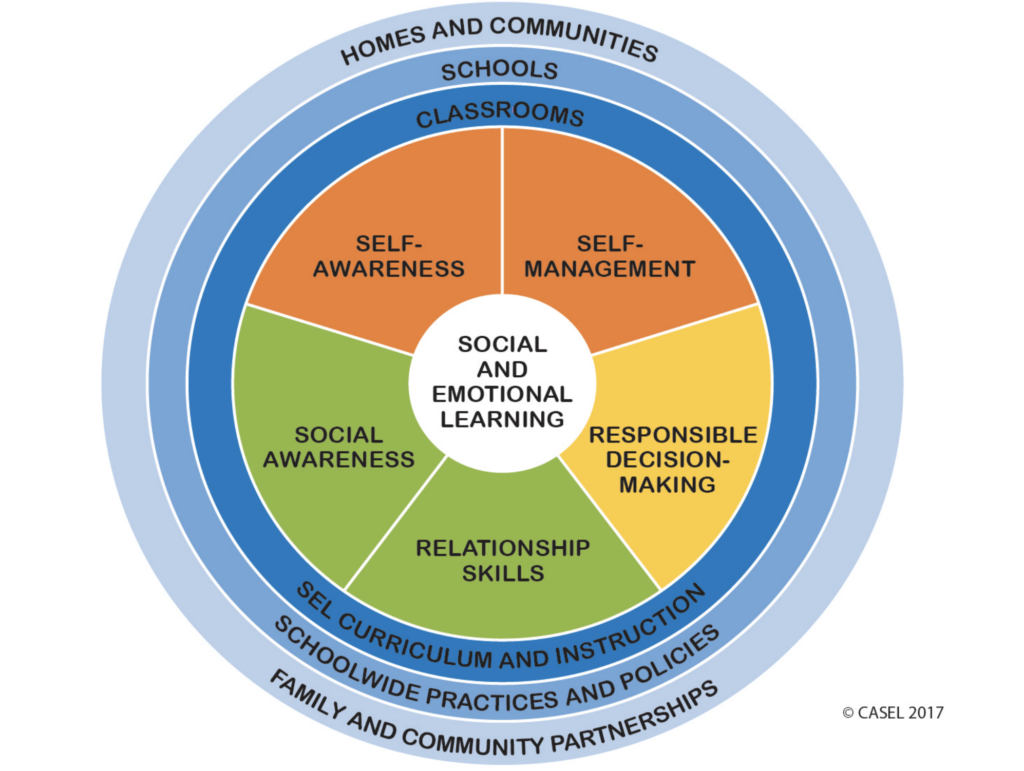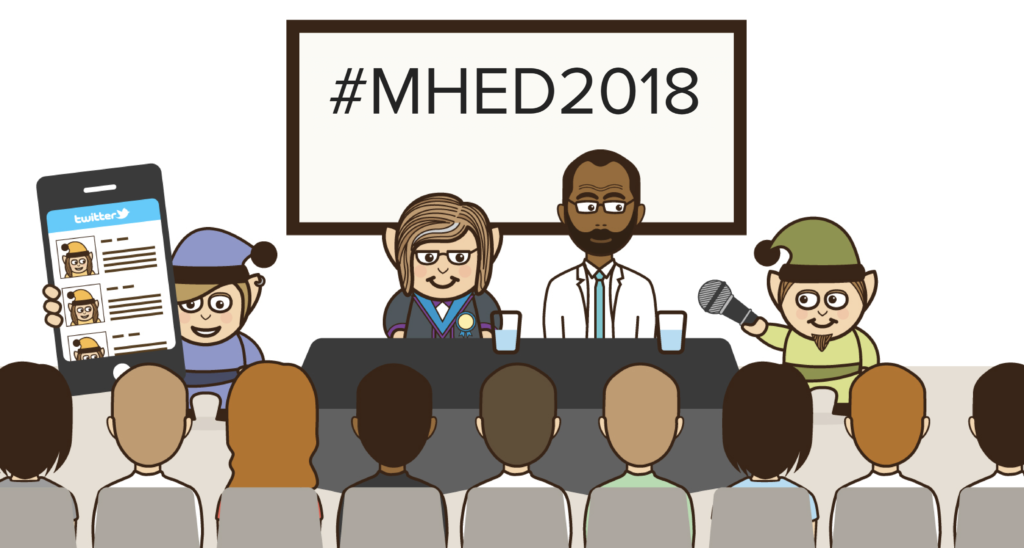
Around 10% of schoolchildren currently experience some form of mental health difficulty, and up to half of adult cases begin in the school years (Green et al., 2005; Belfer, 2008). Being able to intervene early by teaching skills and providing guidance in dealing with later life difficulties before such problems become apparent or entrenched makes sense from a public health perspective, by reducing the burden upon publicly funded systems (e.g. health services). Such an approach potentially offers better outcomes for all children (less children experiencing difficulties and more children likely to ‘thrive’ rather than ‘survive’ in later life). This prevention-based approach is akin to ‘inoculating’ a cohort ahead of potential later difficulties.
It has been suggested that Social-Emotional Competence (SEC) is the framework for the development of such skills and that Social and Emotional Learning (SEL) is the method by which SEC develops. SEL is defined as the process through which children acquire and effectively apply the knowledge, attitudes, and skills necessary to understand and manage emotions, set and achieve positive goals, feel and show empathy for others, establish and maintain positive relationships, and make responsible decisions (Humphrey, 2013). It may be easier to view SEL as two related domains:
- Intra-personal (e.g. awareness and management of one’s own emotional state)
- Inter-personal (e.g. awareness of others emotional states).

Social and emotional competence is typically presented as 5 core competencies, made up from inter- and intra-personal skills. [Reproduced from the CASEL website]
For many reasons, schools are the central nexus by which these skills are taught. This typically takes the form of a (hopefully) coordinated strategy of:
- explicit teaching, typically including a sequence of manualised lessons delivered to the whole class (known as ‘universal’ provision),
- more implicit teaching (such as teachers modelling appropriate behavioural responses, which may or may not involve additional training for teachers)
- and school level policy and practices (e.g. through the display of posters, whole school assembly time and/or reflected in behaviour policies).

Social and Emotional Learning is a way not only to help address early onset difficulties, but also to help reduce the prevalence of later difficulties through promoting a strengths-based framework of skills.
Methods
The article under review summarises some encouraging strands of evidence demonstrating the case for social-emotional competence.
Results
Longitudinal research and mechanisms of change
There is considerable evidence that suggests early development of SEC (i.e during primary school) is linked to positive outcomes later in life, including post-secondary performance and completion, rates of incarceration and levels of depression (Heckman, Stixrud & Urzua, 2006; Moffitt et al., 2011). This is especially true for children who are vulnerable (e.g. showing early poor behaviour) or for those children exposed to numerous risk factors (e.g. disharmonious home life and/or low social economic status). Positive effects are seen after a long period of time beyond the initial teaching, with one study showing students rated by teachers as emotionally competent are more likely to have stable employment at age 25 (Jones et al., 2015).
Further evidence supporting the importance of SEC is provided by examining the underlying mechanisms of intervention, i.e. that skills learnt through SEL are directly related to behavioural change. The paper provides a brief overview of seven studies in which the acquisition of attitudes favouring pro-social over aggressive solutions (e.g. negotiation vs. confrontation) are related to a reduction in aggressive behaviours. Such evidence demonstrates that SEC is linked directly to favourable outcomes such as reductions in violence. However, the paper notes that studies of this type are still limited in number.
School-based intervention research
Linking SEC with later life outcomes does not indicate whether such skills are malleable, e.g. that they are receptive to being taught and learnt. To address this concern, the paper summarises the results from several existing meta-analyses. There is a consistent finding, aggregated across hundreds of individual studies of SEL progammes, that there is a small but positive effect on student outcomes. In the current paper, the findings relate to problem behaviours specifically (effect size = 0.14 to 0.26), but the same studies also analyse other positive outcomes that are important for healthy development, including academic performance, positive social behaviours and emotional distress, which show similar effects. Of interest is whether interventions are more or less effective for particular sub-groups. Although there is far less consistency in what is examined (e.g. not all studies examine effects of age or socio-economic status), but the overall conclusions are that universal interventions are suitable and effective for all students, regardless of gender, location or ethnicity and that they may be more favourable for students from low-incomes families (Durlak, 2011).
The paper concludes by discussing some important considerations in the deployment of SEL programmes within schools. This includes an acknowledgement that some programmes offer more substantive history of being effective than others, and that additional research is required to understand more closely what individual practices and components within programmes are effective. The authors also make a case that schools should be carefully aligning their choice of programme with the needs of their students. Citing the importance of ‘cultural fit’, the authors note that for some groups, unintended consequences can include ‘deviancy training’ by which low-risk students are provided opportunities to become versed in poor behaviour practices. This is a good reminder that the article focuses on universal prevention; a concept distinct from treatment practices.

There are strong links from different strands of evidence to suggest that early Social and Emotional Competence can be taught successfully and is linked to positive later life.
Strengths and limitations
The paper presents an effective summary of a wider body of evidence underpinning the rationale for SEC and it’s link to later life outcomes. This serves as an excellent and informed introduction to some of the evidence supporting the importance of SEL as an essential element of practice for schools and pupils.
However, the article is not (nor does it report to be) an in-depth examination of some of the issues in the practical deployment of SEL for individual school settings. This is important, as there is a great deal of individual variation in how well individual trials of SEL have been seen to work, and more work is still required in more fully understanding optimal conditions for success.
For instance, although there is brief guidance as to general practices (e.g. programmes should be Sequenced (activities to teach skills), Active (opportunities for practice), Focused (time given in the curriculum) and Explicit (targeting of specific skills), the implementation of SEL programmes is a complex matter (indeed, readers are directed to recent guidance from the Educational Endowment Foundation that provides practical advice for the implementation of school-based programmes, and it’s importance and role in producing successful outcomes is still not fully understood.
Similarly, the paper does not acknowledge that much of the evidence is based on ‘efficacy’ trials whereby schools are provided additional and support and training which would unlikely to be replicated in the ‘real world’, or ‘off the shelf’ use of the SEL programme.

This review provides an excellent introduction to some of the evidence supporting the importance of Social and Emotional Learning, as an essential element of practice for schools and pupils.
Conclusions
The article makes a compelling case for the potential offered by implementing universal interventions that promote pupils social and emotional competence. However, there are many potential barriers and considerations that can affect successful outcomes, which are not considered within the article. Readers are directed to the rest of the special issue (of which this paper forms an introduction) for a further examination of some of these factors.
Taking #MHED2018 Beyond the Room!
Look out for live tweeting and podcasting from the #MHED2018 conference on 28-29 June 2018. This landmark conference brings together leading UK and international researchers, policy-makers, educators and allied professionals to explore the intersection between education and mental health and set the future research agenda for the field. The keynote speakers are Louise Arseneault, Mick Cooper, Natasha Devon, Celene Domitrovich, Kate Martin and Dan Olweus.
Read all the MHED2018 blogs that accompany this conference.
You can find out more about our #BeyondTheRoom social media service at beyondtheroom.net

Follow #MHED2018 on Twitter for the latest research, policy and practice relating to education and mental health.
Conflicts of interest
As an academic interested in social and emotional learning, some of Michael’s research overlaps the themes and findings present in the current article.
Links
Primary paper
Domitrovich C, Durlack J, Staley K, Weissberg R. (2017) Social-emotional competence: An essential factor in promoting positive adjustment and reducing risk in children. Child Development, 88, 408-416. [Abstract]
Other references
Belfer, M. L. (2008). Child and adolescent mental disorders: the magnitude of the problem across the globe. Journal of Child Psychology and Psychiatry, and Allied Disciplines, 49, 226–36. Doi:10.1111/j.1469-7610.2007.01855.x [Abstract]
Durlak, J. A., Weissberg, R. P., Dymnicki, A. B., Taylor, R. D., & Schellinger, K. B. (2011). The impact of enhancing students’ social and emotional learning: A meta‐analysis of school‐based universal interventions. Child Development, 82, 405–432. [Abstract]
Education Endowment Foundation (2018). Putting Evidence to Work – A School’s Guide to Implementation.
Green, HA., McGinnity, A., Meltzer, H., Ford, T & Goodman, R. (2005). Mental Health of Children and Young People in Great Britain. Newport: Office for National Statistics
Heckman, J. J., Stixrud, J., & Urzua, S. (2006). The effects of cognitive and noncognitive abilities on labor market outcomes and social behavior (PDF). Journal of Labor Economics, 2006, 24, 411–482.
Humphrey, N. (2013). Social and Emotional Learning: A Critical Appraisal. London: Sage.
Jones, D. E., Greenberg, M., & Crowley, M. (2015). Early social‐emotional functioning and public health: The relationship between kindergarten social competence and future wellness. American Journal of Public Health, 105, 2283–2290. doi:10.2105/AJPH.2015.302630
Moffitt, T. E., Arseneault, L., Belsky, D., Dickson, N., Hancox, R. J., Harrington, H., … Caspi, A. (2011). A gradient of childhood self‐control predicts health, wealth, and public safety (PDF). Proceedings of the National Academy of Sciences of the United States of America, 108, 2693–2698.
Photo credits
- Photo by Kiana Bosman on Unsplash
- US Department of Agriculture CC BY 2.0
- Photo by ketan rajput on Unsplash
- Photo by Ashton Bingham on Unsplash

How would this work when the experience of working in early years education for teachers is minimum wage, long hours, zero hour contracts for subs, often doing multiple jobs to make ends meet, mental exhaustion…
[…] a recent systematic review and meta-analysis of school-based programmes that aimed to improve socio-emotional competence demonstrated positive and sustained improvements in mental health as well as educational and social […]